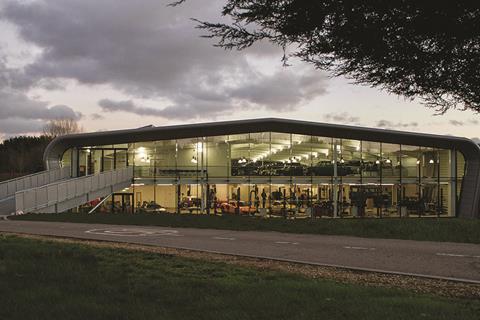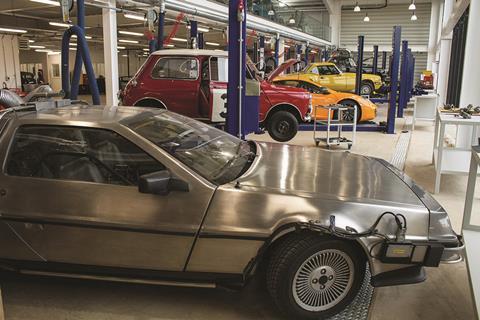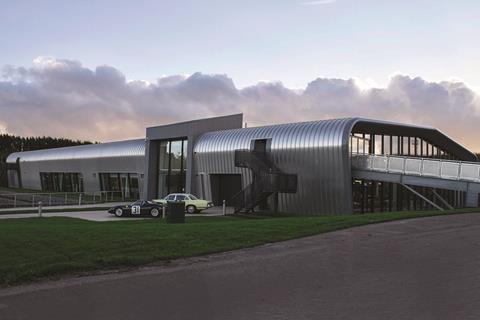Clancy Consulting had to use all its creativity and attention to detail as engineering consultant for the award-winning British Motor Museum to create an innovative building worthy to house the UKŌĆÖs greatest motor vehicles - including a particularly famous DeLorean

ItŌĆÖs a shed. A really, really nice shed! The beauty is you donŌĆÖt just see a shed you see so much more, itŌĆÖs brilliant!ŌĆØ A shed is not the sort of description you would associate with an RICS award-winning project but Clancy ConsultingŌĆÖs M&E director Mike Powers has a right to chuckle as he describes his firmŌĆÖs latest venture.
Appointed to provide engineering consultancy services for the civil, structural and mechanical and electrical works for the British Motor MuseumŌĆÖs new ┬Ż3.9m Collections Centre at Gaydon in Warwickshire, Clancy oversaw the evolution of a design brief that transformed the scheme from a humble shed into the most impressive new tourism destination in the Midlands.
Ensuring that the curved seam cladding melted into the background while complementing the glazed curtain wall was a key feature for the 4,730m2 centre, which was built to house the museumŌĆÖs reserve collection of 250 cars, including a one-of-a-kind Jaguar XJ13 and a DeLorean from Back to the Future.
However, the Collections Centre is more than simply a reserve for the museumŌĆÖs excess automobiles. The structure houses offices, exhibition space and an education centre as well as a behind-the-scenes mezzanine where visitors can peer down on the mechanics who work to keep the vintage cars in good order.
General manager of the British Motor Museum Jeff Coope says the finished project outdid its remit. ŌĆ£They got it. The Clancy team, they got what we were trying to do,ŌĆØ he explains. ŌĆ£They could have built a centre which just fitted the functional brief we gave, but we ended up with something which is much more unique. When you light it up at night itŌĆÖs stunning, the glazed ends allow visual access through the full length of the building.ŌĆØ

A tight brief
However, despite the plaudits, the project wasnŌĆÖt plain sailing. Positioned over a pond which needed to be partially filled to accommodate the new space, the centre is also hemmed in by JaguarŌĆÖs neighbouring test track. The design additionally had to complement the existing museum and adhere to planning restrictions of the rural setting.
Speaking about the construction Coope adds: ŌĆ£We had to design a system of piles and foundations over the pond - we went for a slab design in the end with a lime-stabilised base, as opposed to having a plank and beamed ground floor, which was a bit of an innovation.ŌĆØ
Associate at Clancy, Warrick Pannell, says that early involvement with the client and architect was key to allowing the design to flourish: ŌĆ£Being involved early on meant we could dig into the clientŌĆÖs thoughts and the reasoning behind certain requests and restraints. A lot of innovation went into the building and that imposes quite a load on the civil and structural guys.ŌĆØ
Previous experience in a diverse range of sectors also came to the fore during the design process. According to Powers, the Collections Centre allowed Clancy to draw on the experience of working on high-end retail schemes such as The Mailbox in BirminghamŌĆÖs city centre. This experience allowed Clancy to blend an industrial shell with a design that put people - and cars - first.
He says: ŌĆ£The key to the success of the Collections Centre was bringing the skills from the retail sector and merging it with an industrial space. Somewhere in the middle is a really interesting concept which you find your way to.ŌĆØ
ŌĆ£People donŌĆÖt want to feel they are left looking around a shed - the centre bridges a gap between a museum and storage but it focuses on people who are really involved in their cars. When youŌĆÖre in there the emphasis is all on the exhibits, you donŌĆÖt notice the building at all. ItŌĆÖs simple in the way itŌĆÖs designed, thereŌĆÖs some big steelwork in there and it doesnŌĆÖt try to be anything other than a high-spec industrial building. Where weŌĆÖve got a concrete deck on the lower floor, all services are galvanised, on the upper floor everything was finished white to be as unobtrusive as possible. The beauty is in the simplicity.ŌĆØ
Pannell adds that ClancyŌĆÖs advantage in bringing together these disparate skills sets lay in the size of the firm. With 150 staff spread over nine offices in the UK, Clancy is an award-winning SME with national reach, but without the burden of a big business. He says: ŌĆ£Clancy is an SME with ambition, we think big and we design bespoke. What we have done is grow steadily to ensure we have that attention to deliver as a business for both our projects and staff.
ŌĆ£We work together in a cross cultural environment. Working directly alongside our building services team means as soon as they finish a phone call to the client we can sit and discuss it straight away, picking up on changes very quickly. It streamlines the process.ŌĆØ

Constant dialogue
Two Clancy directors in charge of M&E and C&S worked with Weedon Architects and contractor Galliford Try as the design for the Collections Centre took shape. Powers explains that the firm ŌĆ£embedsŌĆØ directors and apprentices into each project to ensure consistency and quality throughout the business: ŌĆ£From a clientŌĆÖs perspective having a director embedded in the project means they know that we have a vested interest in the success of the project. ItŌĆÖs something a PLC couldnŌĆÖt offer.
ŌĆ£WeŌĆÖre able to pick up knowledge from other Clancy offices and use that on the projects we are working on, we move workloads around the firm to capitalise on specific office or individual expertise and remain in constant dialogue throughout.ŌĆØ
The collaborative approach has led to an abundance of employment awards from inclusion in ║┌Č┤╔ńŪ°ŌĆÖs Good Employer Guide to shortlisting within best place to work and diversity accolades elsewhere in the industry.
However according to Clancy HR manager Jane Saynor, the resource issues affecting the industry as a whole are part of what the firm is tackling head on.
She says: ŌĆ£The industry needs more engineers coming through the ranks and we play our part in tackling this issue and try to do the right thing. The construction industry has an ageing workforce and apprentices are so valuable to us.ŌĆØ
At present approximately 22% of the 150 staff are currently graduates and apprentices, with plans in place to bring in a permanent quota of new recruits and improve access to work for those looking to enter the engineering profession. For those who do enter, they could well be working on the British Motor MuseumŌĆÖs next phase of the collections centre, which is already approved for planning.
As Coope adds: ŌĆ£WeŌĆÖve got what we always wanted with the Collections Centre. Now on to the next one.ŌĆØ
![]()
For more information go to



























No comments yet